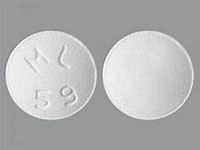strontium ranelate

CLINICAL USE
Treatment of post-menopausal osteoporosisDOSE IN NORMAL RENAL FUNCTION
2 g once dailyPHARMACOKINETICS
DOSE IN RENAL IMPAIRMENT
GFR (mL/MIN)
30–50 Dose as in normal renal function10–30 See ‘Other Information’DOSE IN PATIENTS UNDERGOING RENAL REPLACEMENT THERAPIES
IMPORTANT DRUG INTERACTIONS
Potentially hazardous interactions with other drugsCalcium-containing compounds: separate administration by at least 2 hoursAntacids: separate administration by at least 2 hoursAntibiotics: strontium can reduce absorption of oral tetracycline and quinolones – suspend strontium therapy during treatmentADMINISTRATION
Reconstition
Glass of waterRoute
OralRate of Administration
–Comments
–OTHER INFORMATION
Give between meals as the absorption of strontium is reduced by food and milk productsInterferes with colorimetric methods of blood and urinary calcium concentrationsGive with calcium and vitamin D supplementsSteady state strontium levels are approximately 50% higher in patients with a GFR<25 mL/min compared to patients with normal renal function. No specific treatment effect was detected in patients with renal impairment Fluoride and strontium accumulation in bone does not correlate with osteoid tissue in dialysis patients.Another study found that haemodialysis patients with osteomalacia developed high bone-strontium levels.
)There is no evidence of high levels of bone strontium in dialysis patients being related to osteomalacia.
Oral bioavailability is about 25% strontium ranelate.
See how to identify renal failure stages according to GFR calculation
See how to diagnose irreversible renal disease
Home








